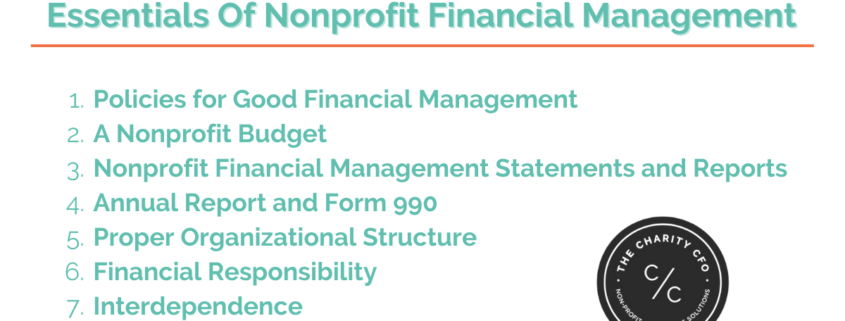7 Essentials Of Nonprofit Financial Management
Many nonprofit organizations tend to let their financial management slip on the backburner as they get busy fulfilling their mission. Sure, your mission should be a priority, but managing finances can’t be neglected either.
Maintaining healthy financial management is critical for the organization’s sustainability, stability, and flexibility, now and in the future. Without a good grasp of your finances, your nonprofit risks:
- Exposure to fraud
- Collaboration issues
- Misuse of funds and poor investments
- Poor financial reporting
- Destruction of physical assets
- Tax issues and non-compliance with regulatory requirements
So, how can you guarantee that your organization is not exposed to any of these risks? Well, the answer lies in understanding and implementing these 7 essentials of nonprofit financial management.
1. Policies for Good Financial Management
Your nonprofit needs to have clearly defined policies and procedures to ensure everyone is on the same page. These rules or principles should reflect your organization’s values and culture. They should clarify the roles, authority, and responsibilities for essential financial management activities and decisions.
Consistent policies will ensure:
- Clear assignment of authority
- Better information dissemination
- Accountability for everyone involved
- Unbiased decision-making
- Streamlined administrative and operational procedures
- Improved transparency for stakeholders
- Timely reporting
- Viability of various projects
When creating these policies, make sure they’re regularly reviewed and updated to keep up with changing circumstances, technological advances, and regulations.
Here are some policies that your nonprofit should implement to maintain proper financial management practices:
Gift acceptance policy
A written gift acceptance policy will guide you on the type of gifts you can accept. The point of creating a nonprofit acceptance policy is to:
- Offer guidelines to staff and board
- Educate the staff and board on critical issues triggered by certain gifts
- Help manage donors’ expectations respectfully.
- Maintain discipline in gift acceptance and administration
- Avoid unnecessary risk, expense, and liability
- Comply with IRS regulations
Asset management policies
Your organization has physical assets, including cash, investments, and other tangible property. You must have a policy that outlines who is responsible for the management of these assets.
Conflict of interest policy
You must strike a balance between the organization’s interests and those of its staff, board, volunteers, donors, and supporters. A conflict of interest policy can help you avoid any misunderstandings or disputes by laying down rules and guidelines for self-dealing, nepotism, kickbacks, bribery, and other related activities.
Nonprofit fiscal policy
These policies outline all internal controls necessary for the management of financial resources. They provide a framework for the oversight and governance of financial operations and activities. When creating your fiscal policy, ensure that it complies with the Generally Accepted Accounting Principles (GAAP).
2. A Nonprofit Budget
A nonprofit budget is a planning document that helps predict expenses, allocate resources, and monitor ongoing operations throughout the year. It documents goals, priorities, and expectations for the financial year and serves as a reference guide to evaluate performance.
A well-formulated budget should focus on the goals and objectives of your organization. It should make a strong statement about your organization’s intentions and aspirations. This will help you make informed decisions and achieve your desired outcome.
This financial planning tool will:
- Help you focus on short and long-term strategic goals
- Keep your donors informed
- Make board members accountable
- Act as your roadmap throughout the year
- Increase transparency in your financial dealings
- Allow you to make more informed decisions
Your nonprofit budget should include the following parts:
- Estimated Revenue: Revenue sources include member dues and fees, events, merchandise, donations, grants, sponsorships, corporate giving, crowdfunding, fundraising, program income, loans, and program-related investments.
- Expenses: Typical expenses include salaries & benefits, insurance, consultant fees, office fees, travel, professional development, utilities, marketing and advertising, program expenses, and fundraising expenses.
3. Nonprofit Financial Management Statements and Reports
Financial statements are a set of reports that summarize the financial position and activity of a nonprofit. These include:
- Statement of financial position
- Statement of activities
- Statement of functional expenses
- Statement of cash flow
Statement of financial position (Nonprofit balance sheet)
A statement of financial position provides a snapshot of the financial health of your nonprofit. It measures the nonprofit’s assets, liabilities, and net assets at a particular point in time.
This tool provides several insights:
- The overall financial situation of your organization
- The level and composition of assets
- Your organization’s ability to pay its debts
- Sources of your organization’s income and expenses
- Your capacity to launch new initiatives and programs
- Any potential risks related to financial stability
- Changes in the financial position of the nonprofit over time
Statement of activities (Income statement)
This statement provides a birds-eye view of your organization’s financial activities. It tracks the flow of money coming in and out of your organization during a particular reporting period. It also reflects the changes in your organization’s net assets resulting from income and expenses during that period.
It is split into 3 sections:
- Revenue
- Expenses
- Net assets (difference between revenue and expenses)
SOA helps to:
- Identify programs that need tweaking if they’re not working optimally
- Ease the tax reporting
- Bring GAAP compliance
- Create transparency and accountability required by the board and IRS
- Distribute funds appropriately between departments, initiatives, and programs
- Gauge the effectiveness of fundraising efforts
Statement of functional expenses (SOFE)
This statement shows how much money is being spent on each function or program within the organization. Your donors, funders, and the IRS are particularly interested in this statement as it provides insight into how funds are being spent.
SOFE helps answer questions related to:
- How much money are you spending on fundraising efforts?
- What percentage of your budget is going towards administration costs?
- How effective are your programs at achieving intended outcomes?
- Are funds being allocated appropriately and efficiently?
- Is there a need to invest more in particular projects or initiatives?
Cash flow statement (CFS)
This is a document that outlines all of your organization’s cash inflows and outflows over a period of time. It reports the total amount of cash available to your organization at the end of the reporting period.
4. Annual Report and Form 990
While you can simply use form 990 as your annual report, creating a more comprehensive annual report that includes financial information as well as programmatic and other activities is highly recommended. It helps to:
- Market your mission
- Tell your organization’s story
- Highlight the impact on your community
- Thank your donors
- Appreciate volunteers
- Summarize last year’s initiatives
- Drum up support for upcoming programs and initiatives
The annual report should include the following:
- Executive summary
- Financial statements
- Program reports
- Donors and sponsors list
- Management and board report
- Photos and messages from beneficiaries
- Links to your social media channels
5. Proper Organizational Structure
It is important to have a robust organizational structure and policies in place to ensure your nonprofit runs efficiently. These include:
- Organizational charts
- Policies for financial management, human resources, and privacy
- Roles and responsibilities of board members and staff
- Processes for approving new programs, initiatives, and expenses
- Risk management strategies
6. Financial Responsibility
As a nonprofit leader, you have the responsibility to ensure that your organization’s assets are appropriately managed and used for their intended purpose.
This involves ensuring compliance with all accounting, reporting, and disclosure requirements. It also involves staying up to date on the latest auditing standards, tax regulations, and IRS filing requirements.
This can be achieved by conducting periodic internal audits, appointing a CFO or finance officer to oversee the financial health of your organization, and adhering to GAAP best practices in nonprofit accounting.
7. Interdependence
Financial management is an organization-wide effort. It is not just about the money–it’s about strategy, governance, and leadership. Keeping everything connected should be at the heart of your approach to financial management. Communicate regularly with key stakeholders to ensure that everyone is on the same page.
Always Be Report-Ready With Accounting Solutions Built for Nonprofits
Accounting for nonprofits does not have to put an excessive strain on your resources. You can access high-end accounting solutions specifically built for nonprofits to help you streamline your financial management processes. This can help save time, money, and resources in the long run and ensure accuracy and transparency.
At TheCharityCFO, we provide bookkeeping services, budgetary reconciliation, real-time tracking of your financial health, and specialized data analytics to help you make informed decisions. Our expert team of CFOs can provide guidance on best practices and help you stay compliant with IRS regulations.
Contact us today to learn more about our customized accounting solutions that have helped hundreds of nonprofits just like yours.
No time to read this article now? Download it for later.







